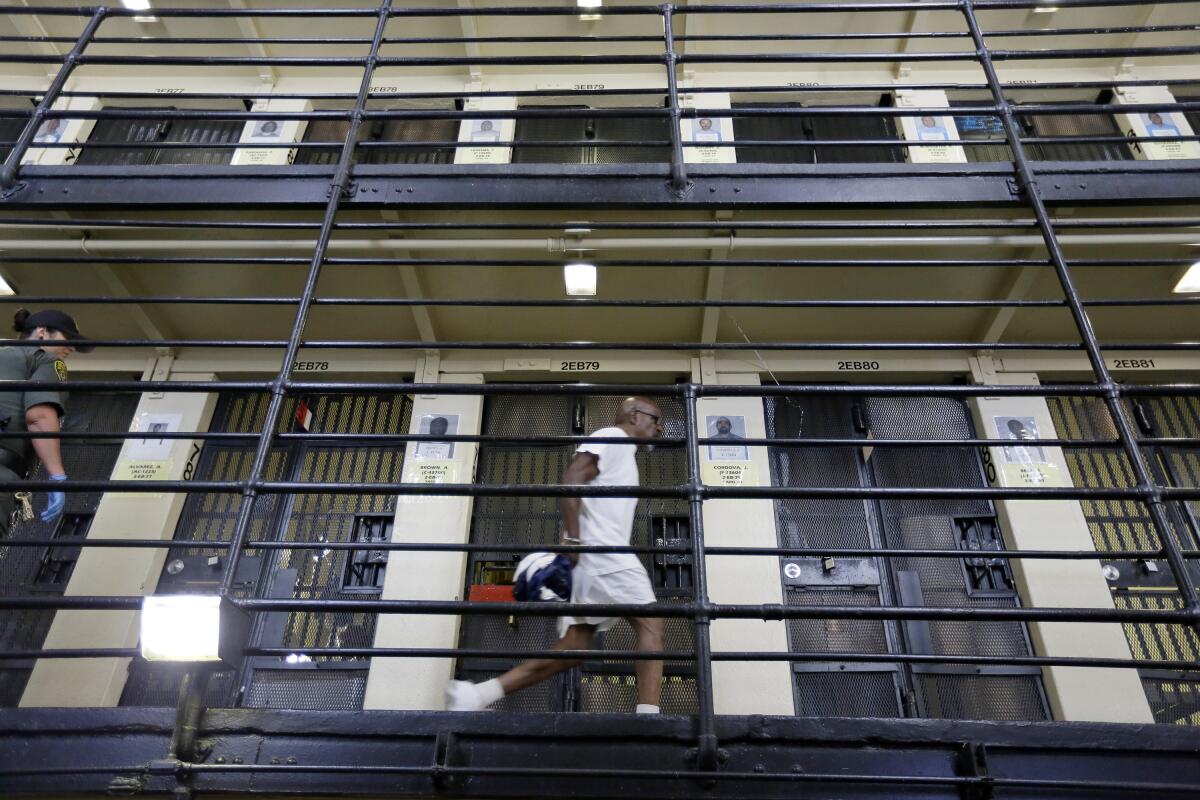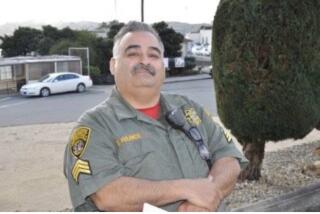We pleaded for social distancing here in San Quentin. The state refused, and now COVID is raging

- Share via
I am fully vaccinated and boosted against COVID-19. I do everything I can to follow the CDC’s guidelines for protecting myself against infection. Yet I fear catching COVID-19 a second time from the sick people all around me in San Quentin State Prison.
I am one of 300 plaintiffs who sued the state of California, seeking a court order that would have forced prison officials to ease overcrowding and house one person to each cell, instead of two. Our goal was to increase social distancing in the enclosed, unventilated housing units that are packed at well more than 100% of intended capacity.
In his ruling in the lawsuit last November, Marin County Superior Court Judge Geoffrey Howard acknowledged that “in double-occupancy cells, one person cannot avoid infection if the cellmate has contracted the virus.” Looking back at the 28 deaths in the prison to date, he ruled that officials’ mismanagement amounts to cruel and unusual punishment, violating the U.S. Constitution.
Nevertheless, he would not order the prison to house only one person per cell. He denied the petitions, saying that vaccines were “a game changer.”
Today, as the highly infectious Omicron variant swamps hospitals across the country, shatters caseload records (including among the vaccinated), and has infected 335 people in San Quentin in the 14 days leading up to Jan. 25, this statement has not aged well.
My neighbors and I knew it wouldn’t. It was never “speculative” to note that the coronavirus is mutating into unpredictable variants. At the time of the judge’s decision, the Delta variant had already ravaged the U.S. for months. As an April 2021 article in the New England Journal of Medicine noted, vaccines alone are not enough to stop coronavirus outbreaks in prisons. San Quentin’s current spread is further fueled by the fact that 23% of administrators and correctional officers have chosen to remain unvaccinated — a choice vigorously defended by Gov. Gavin Newsom.
Meanwhile, instead of releasing people to address overcrowding, California has packed more people into San Quentin, with the population swelling from a low of 2,418 last May to about 3,092 this January. More than 500 of the prison’s 3,081 cells remain unused, leaving people doubled up in 4-by-9 cells, with access to fresh air left to the whim of prison officials. Coronavirus cases are stacking up.
Judge Howard’s gamble is being tested. The stakes are our lives.
The San Quentin coronavirus outbreak, which a state appeals court called the “worst epidemiological disaster in California correctional history,” can be traced to May 30, 2020, when the California Department of Corrections and Rehabilitation transferred 122 prisoners from the California Institute for Men (Chino) to San Quentin, against medical recommendations and the department’s own policies. The result: thousands of lives unraveled.
As the pandemic spread through the prison, officials made mistake after mistake — mixing sick and healthy people, failing to separate housing units, failing to enforce a mask mandate, delaying testing and maintaining a dangerously high population in the prison.
“The tragic, inevitable result of this bumbling sequence of events was an exponential COVID-19 outbreak at San Quentin that, to date, has killed 28 people,” Judge Howard wrote.
He also noted that the state has a “long and notorious history of providing constitutionally inadequate medical care to California inmates.” In 2011, the U.S. Supreme Court ruled that “severe overcrowding” made it impossible for the state to provide constitutionally required medical and mental health care in its prisons. Today, California prisons remain at 112% of design capacity. Until numbers are reduced — not only at San Quentin, but throughout the state — incarcerated people will never be safe.
It’s not just COVID-19 we have to worry about. We also cannot escape any other infectious disease brought inside this prison. Reducing prison populations and housing only one person per cell will not alone solve the problem, but those steps would decrease infection rates and save lives.
It’s not rocket science. The more human beings are crowded into tight spaces, the easier it is for sicknesses to spread.
“We’re still in danger every moment, physically and psychologically,” Miguel Sifuentes, a fellow plaintiff in the lawsuit, told me. “Whether it’s another variant or a different illness, or the cumulative effects of overcrowding, we remain in danger because we don’t know when either is coming.”
He said he would like Judge Howard to reconcile the logic of acknowledging the violation of our rights during the pandemic, the long history of prisons’ deliberate indifference to our medical needs and even what the judge called the “evolving nature of the pandemic” — yet not providing us any relief.
Richard “Rock” Lathan, 52, another plaintiff, has been incarcerated for more than 30 years. He testified that he contracted COVID-19 while working on a team that cleans up after medical emergencies. “I still do it, because I care about those still being affected by COVID, the long haulers and the sick,” Lathan told me.
“These cells are originally built for one man. It’s like living in a gas station bathroom with two people,” he said. “Spend a night or a week in one of these so you can see for yourself what it’s like and how the atmosphere is and how easily someone can get COVID again, even though we’re vaccinated.”
We can only hope that the courts — as well as the governor, state legislators, policymakers and the people of California — will hear our pleas.
Incarcerated journalist Juan Moreno Haines is senior editor of the San Quentin News and a contributing writer at Solitary Watch.
More to Read
A cure for the common opinion
Get thought-provoking perspectives with our weekly newsletter.
You may occasionally receive promotional content from the Los Angeles Times.









